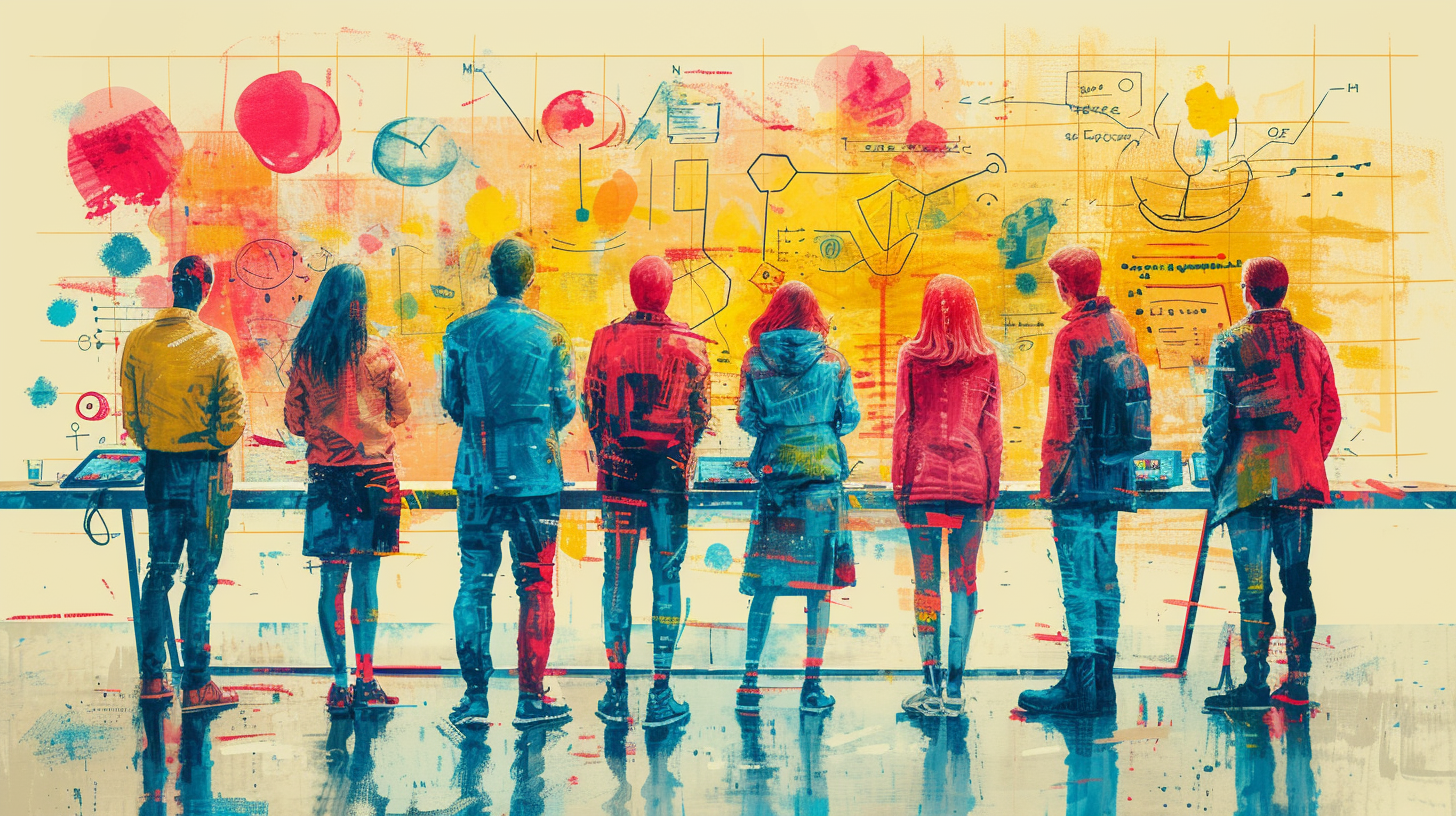Introduction
As technological change and the adoption of new technologies like artificial intelligence (AI) accelerate, the future of human work will be characterized by disruption, uncertainty, and opportunity. As 2024 approached, the Team Flow Institute Research Fellows gathered for a roundtable to discuss their visions for the future of human-focused work in the age of AI.
As described by the institute’s co-founder and Managing Director, Chris Heuer, “The Team Flow Institute is an organization dedicated to shaping a human-centric future of work as we face the choice of augmentation or automation in every industry and every function. This transformational decision will reshape what we call work and society itself, requiring us to abandon business as usual and finally design business as possible.”
The Team Flow Institute Research Fellows’ roundtable discussion delved into the potential opportunities and challenges of this technology revolution driven by the institute’s “mission to gather like-minded individuals and organizations to steer our collective destiny toward a more sustainable future, where the essence of humanity and human work is valued and preserved as we increasingly adopt AI tools and technologies, explained Jennifer McClure, Senior Research Fellow, and Advisory Board member.
This article analyzes key insights from the discussion, offering a glimpse into the work landscape of 2024 and beyond. As the Team Flow Institute embarks on its inaugural fellowship program, this analysis holds particular significance as it seeks to equip individuals with the knowledge and skills necessary to thrive in the evolving landscape of AI-enabled work. Through this program, the Team Flow Institute aims to foster a community of leaders who can guide organizations and individuals toward a future where humans and technology collaborate to create a more sustainable and fulfilling work environment.
Part I: AI Progress and Promise
No longer relegated to science fiction, AI has infiltrated our lives, transforming industries with its vast potential. From automating tedious tasks to streamlining complex decision-making processes, its applications are far-reaching. In the realm of design, AI-powered software is revolutionizing industries like architecture and fashion, enabling rapid prototyping and personalized creations. Team Flow Institute co-founder Jaime Schwarz says, “Imagine being able to prototype a new building or clothing line in minutes instead of weeks. This remarkable advancement accelerates design cycles and fosters increased customization, ultimately leading to more innovative and personalized consumer products.”
The creative landscape is also poised for disruption with the emergence of generative AI. Team Flow Institute Research Fellow Shel Holtz describes its transformative potential: “Generative AI is blurring the lines between human and machine creativity. We’re seeing machines create realistic text, images, and even music that is nearly indistinguishable from human-generated work.” This democratization of creativity opens doors for individuals with diverse backgrounds and abilities to express themselves in new and exciting ways. But it also opens up philosophical questions and debates about the nature of art and creativity, adds Jen McClure.
Amidst these exciting advancements, Chris Heuer reminds us that “AI is not just a science fiction concept anymore; it’s here, and it’s changing the way we do everything.” This necessitates a thoughtful approach to the future of work, a need to ensure the value of human skills and their role in work, proactive workforce development initiatives to ensure that individuals are equipped with the necessary skills to thrive in the evolving job market, and an elevation of the need for constant communications within organizations, reminds Team Flow Institute Research Fellow Sharon McIntosh.
As AI continues to permeate our lives, it is crucial to acknowledge its remarkable potential and challenges. By navigating this dynamic landscape with careful consideration and proactive planning, we can ensure that AI serves as a force for progress, innovation, and a brighter future for all. As Team Flow Institute Research Fellow Gina Debogovich reminds us, it will undoubtedly unlock economic growth. “The 20th century began with a global GDP of $3 trillion and, largely due to technological advancement, ended with a GDP of $33.8 trillion. AI is poised to boost the economy to unseen heights.”
AI will be a catalyst for creating new jobs, just as the web did in the mid-1990s. Businesses must integrate these jobs and activities into existing workflows and business models and develop new ones. Indeed, innovative organizations are already experimenting with, if not embracing, the role of prompt engineers. The Team Flow Institute advocates for a Team Flow Facilitator to serve as a coach, a collaboration facilitator, and an AI pilot to support high-performing teams.
Part II: The Risks and Downsides
While AI offers many benefits, possibilities, and opportunities, its advancements are not without potential pitfalls. AI and automation technologies bring both promise and peril to the workforce. While they offer the potential to augment human capabilities and business efficiencies significantly, understandable concerns persist surrounding job losses and the general impact on workers. Organizations must chart a thoughtful course that fully harnesses technical capabilities without losing sight of the humans at the heart of work.
Team Flow Institute Research Fellow Steve King cautions, “The rapid adoption of AI could lead to significant job losses in certain sectors, particularly in sectors where tasks are easily automated.” This underscores the critical need for reskilling and adaptability initiatives to ensure workforce resilience in the face of technological change. Rather than a binary conception of AI versus human jobs, the near future entails integrated teams involving both augmented professionals and AI systems working together. Determining optimal workflows and processes to take advantage of relative strengths will be crucial. Leadership development must evolve to enable oversight of blended teams comprising internal employees, external partners, and AI agents.”
Another concern revolves around the potential for AI consolidation and its ability to exacerbate existing inequalities. Jen McClure aptly describes the potential issue: “AI could further marginalize vulnerable populations and widen the economic gap between different segments of the workforce. To address this concern, proactive measures are needed to ensure equitable access to AI technology and its benefits.”
As generative AI develops and is embraced at scale, there is a growing concern about equity and mitigating the risk of unconscious bias, beliefs, and prejudices in its design. Team Flow Institute Research Fellow Zora Artis emphasizes the need for a deliberate and thoughtful approach to AI development to ensure fairness and inclusivity. “When it comes to AI and automation’s impact on the future of work, embedding diversity, equity, and inclusion from the outset is essential. Prioritizing inclusive design, training, continuous ethical oversight, and robust governance practices are some of the strategies to consider. By incorporating these elements, we can work on creating a better workplace for all.”
Furthermore, the rise of deep fakes poses a significant threat to trust and information integrity. As Jen McClure warns, “Deepfakes have the potential to erode trust in institutions and manipulate public opinion, making it increasingly difficult to discern truth from fiction. This necessitates the development of robust safeguards and regulations to mitigate the dangers of deep fakes and ensure responsible use of this technology.”
In addition, Sharon McIntosh warns of the potential isolation of working in a world dominated by technology, noting employees feeling unprepared in social aptitudes as they enter the world of in-person work—a deficit compounded by the proliferation of often solitary machine interfaces.
Navigating the risks and downsides of AI requires careful consideration and proactive planning. By acknowledging the potential challenges and implementing appropriate measures to address them, we can ensure that AI advancements serve the greater good and contribute to a more equitable and secure future for all.
Part III: Preparing for the Future of Work
As AI transforms the work landscape, uniquely human skills like critical thinking, creativity, and emotional intelligence become increasingly valuable. As Team Flow Institute Research Fellow Shel Holtz states, “While AI is undoubtedly powerful, it can’t replicate the unique qualities that make us human.” These human strengths will be crucial for navigating the complexities of the future workplace and ensuring that technology serves as a tool for augmentation, not replacement.
Team Research Institute Research Fellow Alan Berkson added, “While automation handles rote information processes well, activities like critical thinking, empathy, and creativity remain firmly human domains.” Berkson, therefore, suggests reevaluating talent development and performance management to nurture uniquely human strengths. “As analytics and algorithms influence more decisions, managers should emphasize judgment, communication excellence, and the ability to cultivate trust. We must move beyond metrics focusing solely on output and consider broader measures that capture the full spectrum of human contributions, including critical thinking, problem-solving, and collaboration. Shifting our focus to these diverse skillsets will ensure that we value the unique contributions humans bring to the table in an AI-powered workplace.”
Additionally, Sharon McIntosh advocates revamping employee training given the profound generational learning differences.“In a world of increasingly remote, hybrid, and technology-enabled work, leaders cannot assume new hires arrive with the basic office and collaboration skills that previous generations had.” As such, leaders should avoid assuming that new team members can learn critical job skills indirectly or casually without formal training.
Navigating the evolving job market will require career resilience and adaptability. Chris Heuer states, “The future of work will be characterized by constant change, requiring individuals to embrace continuous learning and develop the skills necessary to adapt to new technologies and situations.” Fostering a culture of lifelong learning and reskilling initiatives will be crucial for equipping individuals with the tools and resources they need to thrive in the face of technological advancements.
By recognizing the importance of uniquely human skills, adopting a broader view of worker success, and encouraging continuous learning, we can prepare ourselves for the future of work and ensure that humans remain central to the equation. Embracing these key strategies will enable us to leverage AI as a powerful tool for progress while safeguarding humanity’s unique value to the workplace and beyond.
Part IV: Team Flow as the Key to Human-AI Synergy
As automation reshapes the work landscape, the need for high-performing teams becomes increasingly critical. As Chris Heuer emphasizes, “In an environment where AI is augmenting human capabilities, strong team dynamics become the foundation for success.” The Team Flow Model, developed by Jef van den Hout, provides a valuable framework for fostering collaboration, trust, and optimal performance within hybrid teams. By applying the Team Flow Model, organizations can optimize team dynamics and ensure that AI is a tool for augmentation, not replacement.
Jen McClure states, “AI should be seen as a collaborator, not a competitor. By leveraging its capabilities alongside uniquely human strengths, we can unlock a new level of performance and innovation.”
This approach empowers teams to leverage the strengths of both humans and machines, resulting in increased efficiency, problem-solving capabilities, and creativity. As Shel Holtz says, “When humans and AI work together seamlessly, we can achieve remarkable things that would be impossible for either alone.”
However, implementing the Team Flow Model to seize the advantage in this new future of human work requires a foundational shift in mindset and organizational culture. Steve King points out, “Organizations need to move away from hierarchical structures and embrace a more collaborative approach that empowers teams to make decisions and own their work.”
“Fostering an environment of trust, autonomy, empowerment, and psychological safety is crucial for encouraging open communication, collaboration, and innovation,” added Sharon McIntosh.
By embracing the Team Flow Model and its principles, organizations can unlock the full potential of human-AI synergy. This approach enables teams to thrive in the age of automation, ensuring that humans remain central to the equation and that AI serves as a powerful catalyst for progress and innovation.
Chris Heuer emphasizes that “Positive socioeconomic change requires us to ask the question, what will it take for us to break free from business as usual to finally and fully create business as possible?”
Part V: Looking Ahead to 2024: A Glimpse into the Future of AI and Work
As the Team Flow Institute Research Fellows looked toward what 2024 would bring, the discussion highlighted several key trends that will continue to shape the future of AI and work:
1. Seamless AI Integration: AI integration will no longer be relegated to specialized tools and applications. Instead, it will become increasingly embedded within our everyday work environment, seamlessly integrated with existing software and platforms. This ubiquity will necessitate a shift in mindset, as individuals will need to become accustomed to interacting with AI in various forms throughout their workday.
2. Rising Demand for AI Skills: The demand for AI literacy and skills will continue to rise exponentially. As AI becomes more pervasive, individuals possessing knowledge and experience in AI development, deployment, and management will be highly sought after. To prepare for this evolving landscape, educational institutions and training programs will need to adapt their curricula to equip individuals with the necessary skills to thrive in the AI-powered future.
3. Ethical Considerations at the Forefront: As AI technology continues to advance, ethical considerations surrounding its development and deployment will become increasingly paramount. Concerns regarding access, bias, fairness, data privacy and accuracy, transparency, and cyber risks posed by AI must be addressed proactively to ensure that AI is used responsibly and ethically. Engaging in open dialogue, fostering diverse perspectives in the development process, and establishing robust ethical frameworks will build trust and ensure that AI serves the greater good.
4. Expanding Role of Government Regulation: As the potential impact of AI becomes increasingly evident, the role of government in regulating this technology is likely to expand. This regulation should ensure responsible and equitable use of AI, mitigating potential risks and safeguarding individual rights and privacy. Collaborations between government, industry, and academia will be essential in crafting effective regulations that promote innovation while protecting the public interest.
By proactively addressing these trends and focusing on AI’s ethical development and deployment, we can ensure that this powerful technology serves as a force for positive change and progress in the years to come. Embracing lifelong learning, fostering open collaboration, and prioritizing ethical principles are essential for navigating the evolving landscape of AI and work and building a brighter future for all.
Calls to Action: Empowering Your Organization for the AI-Powered Future
As we stand poised on the precipice of a transformative era, proactive action is crucial to ensure your organization thrives in the AI-powered future of work. Here are five key calls to action:
1. Embrace Team Flow to ensure a human-centered approach to work: Explore the Team Flow Model and its resources. By understanding the dynamics of teams performing human work, you can cultivate collaboration, trust, performance, and well-being within your hybrid or fully remote workforce. Striving to achieve a state of team flow will empower your teams to leverage AI as a tool for augmentation, unlocking its full potential while ensuring our humanity remains central to the equation.
2. Champion the Ethical Development, Adoption, and Use of AI: Advocate for ethical and responsible AI development. Raise awareness within your organization and community about the importance of transparency and accountability in AI development and deployment. Support initiatives that promote ethical frameworks and best practices, ensuring that AI serves the greater good and mitigates potential risks. In this moment, where the potential risks and rewards are plainly recognized, we have the unique chance to choose how to design our future.
3. Invest in Skills Development: Invest in learning and development programs. Equip your workforce with the necessary skills and knowledge to navigate the evolving landscape of AI. Whether it’s AI literacy, technical expertise, or soft skills like critical thinking and decision-making, providing ongoing learning opportunities will empower your employees to adapt and thrive in the face of change.
4. Foster a Culture of Collaboration & Innovation: Cultivate a culture of collaboration and continuous learning within your organization that doesn’t penalize failures but recognizes all outcomes as valuable lessons. Encourage open communication, knowledge sharing, and a mindset of lifelong learning. This will create an environment where individuals feel empowered to embrace new technologies, experiment with innovative approaches, and adapt to the ever-changing demands of the workplace.
5. Establish Governance for AI Integration: Prioritizing responsible governance measures for AI integration fosters ethical technology development critical for risk reduction and positive organizational impact. This involves creating clear policies to oversee AI usage, addressing concerns such as data accuracy, security, compliance with regulatory standards, and building familiarity with AI amongst the workforce. Doing so ensures responsible, ethical, and successful adoption of AI.
By taking these actions, you can position your organization at the forefront of the AI revolution. By empowering your teams, prioritizing ethics, and fostering a culture of continuous learning, you can ensure that AI serves as a catalyst for progress, innovation, and a fulfilling future for all.
Conclusion: A Future Brighter Together
While AI and automation have a transformative impact on the future of work, it is through human ingenuity and collaboration that we can unlock its true potential. Embracing lifelong learning, fostering ethical practices, and prioritizing human-centered solutions are not just suggestions but the cornerstones of a thriving and fulfilling future. The future of work is not a preordained path but an open canvas awaiting our collective action, positive intentions, and creativity. Let us paint a future where technology augments and amplifies our capabilities instead of replacing them. Let us build a future where human potential shines brightly, illuminating the path toward a brighter tomorrow for all.
In this endeavor, the Team Flow Institute stands as a guiding light. Through its insightful discussions, valuable resources, and impactful fellowship program, the institute empowers individuals and organizations to navigate the evolving landscape of AI and work. By fostering collaboration, promoting ethical principles, and cultivating a culture of lifelong learning, the Team Flow Institute is at the forefront of shaping a future where humans and AI work together in harmony, driving progress and innovation for the benefit of society, not just the powerful few.
Together, let us embrace AI’s opportunities while thoughtfully addressing its challenges with foresight and wisdom. Let us harness the power of technology to augment our strengths, not replace them. Let us choose a future where human ingenuity and collaboration are celebrated, and human potential continues to shine ever brighter. This is the future we will collectively create, a future where technology empowers us, not replaces us, and where human potential continues to thrive and illuminate the path towards a brighter tomorrow for all.



